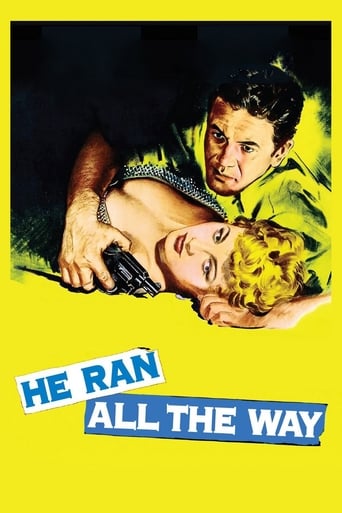jeffhaller125
Good actors like Wallace Ford. Selena Royle and Shelley Winters cannot save a script that plays as if they made it up as they went along. The main character is psychotic and has not a drop of sympathy. He isn't evil simply because Gladys George was a bad mother. Winters' character is pathetic: a mousy girl still living with her overprotective parents and kid brother. She comes off as semi mentally retarded. There really isn't any understanding of Garfield's behavior since the script gives us only tiny pieces about his past. The movie looks great. Wonderful photography and a very gritty atmosphere, but the 77 minutes eventually feels a lot longer. It's a shame that Garfield's swan song was probably his worst picture.
LeonLouisRicci
Filmed in the Shadow of HUAC and the Communist Witch Hunt and Blacklist, this Film-Noir is a Strikingly Photographed, dreadfully Atmospheric, Downbeat of a Movie that is Pure Noir and John Garfield's Last Movie.The Pain in the Performance can be seen as a Physical (heart trouble) and Mental (hounded by the McCarthyites) Breakdown occurring On Screen and in Real Life. It is a Powerful Portrayal by Garfield.The Opening Act is Gloomy as Garfield is living with a Mom from Hell in a God-Awful apartment in the Slums. One of the opening Lines of Dialog...Mom: "If you were a Man you'd be out looking for a job."...Garfield: If you were a Man I would kick your teeth out."There is more Noir Nastiness. A botched Payroll Robbery and a Chase through the Train Yards that leads to a Public Swimming Pool, all Filmed with Gritty Noir Realism by Cinematographer James Wong Howe. The Script was Fronted but Written by Dalton Trumbo (HUAC) and Directed by John Berry (HUAC),This is as Bleak as Noir gets with an Ending that is the Genre at its most Definitive. A Must See for the fine Cast, Crackling Dialog and Shadowy Style. It is a Great Exit for Garfield and is a True representation of the Actor and the Man's Feelings articulated in His Art, Symbolic of His Philosophy and Politics.
ssthompsonIII
While watching this movie, for the first time, I thought I saw John Wayne and Gary Crosby in two crowd scenes. Here they are;Wayne walking with a women in the scene where Garfield is about to get in line at the swimming pool. Gary Crosby,sitting on a bench in the men's locker room when Garfield is looking for the locker to change into his swimming trunks. You have to look fast,especially for John Wayne, he was the tallest man in the crowd scene.Any one else notice this? Any information about the filming locations would be helpful, was raised in L.A. and it appears many scenes are long gone, the 'plunge' was near Santa Monica or Venice,recall that Pacific Electric Red Cars used to take passengers there and the 'plunge' used sea-water. The apartment looked like the Bunker Hill area.Street car bells could be heard in the apartment scenes.
Robert J. Maxwell
Pretty decent cast -- John Garfield, Wallace Ford, Selena Royle -- but the film is no more than routine. Garfield is a gangster who has just committed a payroll robbery. On the run, he takes refuge in the working-class apartment of a girl he just met, Shelley Winters, and her family -- Mom, Pop, and kid brother. His identity is discovered by the family and he quietly takes them hostage, holding a snub-nosed .38 on them. But what's he going to do with them? How is he supposed to get away with the dragnet out for him? Mom and Pop are quietly repulsed by him, but Winters is attracted and evidently spends the night with him, intending to accompany him on his getaway. He sends her out to buy a car with part of the payroll money but comes to believe she didn't buy the car. Instead, she's betrayed him to the police. In the end, she's forced to shoot him at the doorway to the apartment house. He looks surprised, says, "You never had no love for me," stumbles out the door, only to discover before he collapses that she'd been true to her word. There sits the car. And Garfield plops into the rain-filled gutter.Mostly -- throughout the movie -- they talk. Then they talk more. Then they go on talking more. Garfield's character emerges as embittered and cynical, self pitying, angry at those who have betrayed him all through his life, beginning with his mother.But he's not very smart. He allows the family to go out in order to show up at work or run errands, as long as he has one member at home for a hostage. While the rest are absent, in a burst of generosity and hope, he has an elaborate turkey dinner prepared. When they return, he beams with pride and tells them to dig in. But they remain silent, and Mom produces some left-over stew, which they proceed to spoon out without enthusiasm. "I don't get it," says Garfield. "What's the mattah with the toikey? Ga head -- cahve it up." Pop tells him solemnly, "This is our dinner. The turkey is YOUR dinner." Garfield is dumbfounded. "Huh? Oh -- I GET IT." (Finally.) It could easily have been a radio play, still popular at the time (1951) or a live TV show from Playhouse 90. The budget is low and the story skeletal. Usually they find room for remarks about how this is going to be the hottest day of the year or something. Here the patter is limited to remarks about the future, about good character, about responsibility, and they lead nowhere.I usually find John Garfield's performances likable -- another lower-middle-class guy from New York -- but never magnetic. Shelley Winters usually gets panned but I don't know why. She's never bad, and often better than the script calls for.




